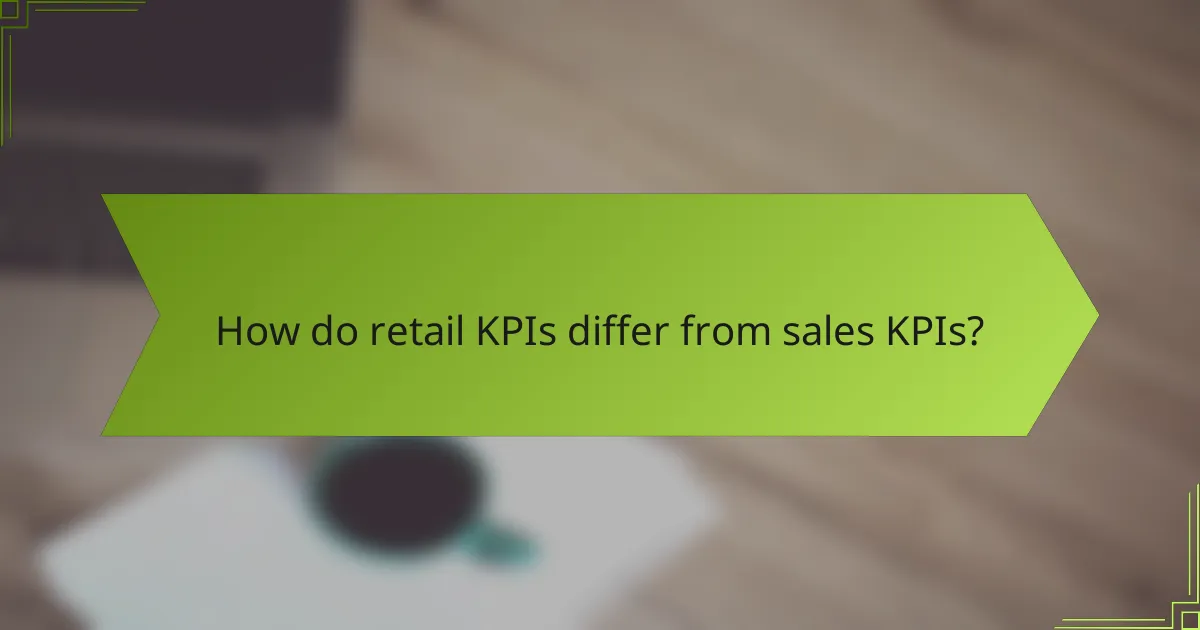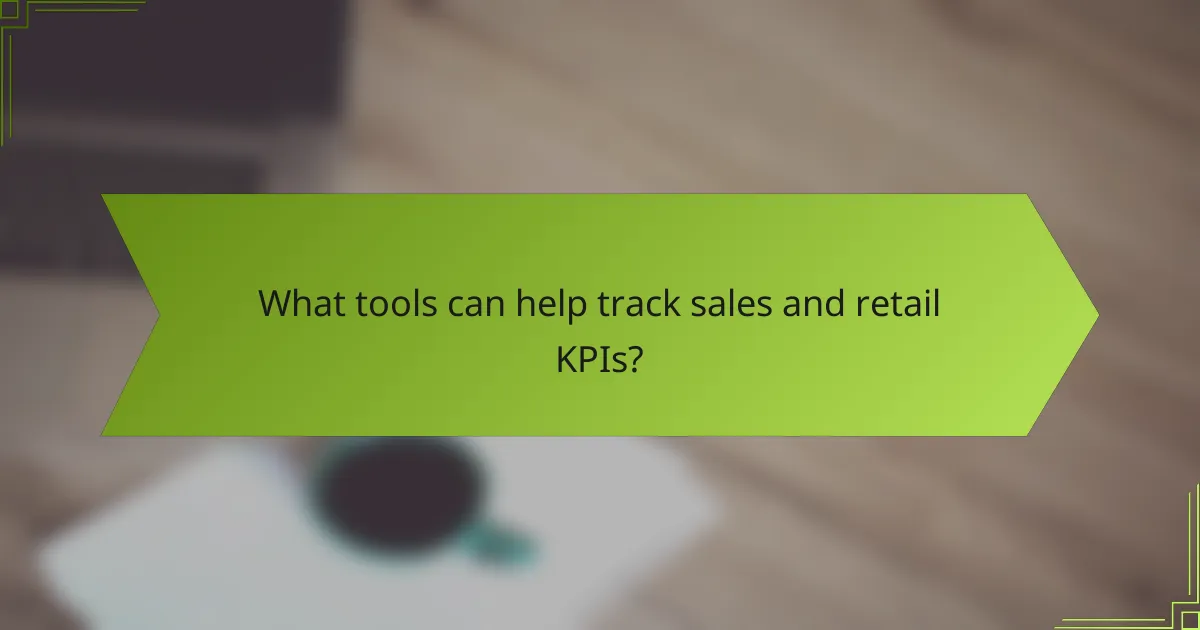Key performance indicators (KPIs) for sales are essential metrics that reveal how well a company is meeting its sales goals. By distinguishing between retail and sales KPIs, businesses can fine-tune their strategies to improve both in-store and online performance. Utilizing effective sales dashboards allows teams to visualize these metrics, facilitating real-time tracking and informed decision-making to enhance overall sales effectiveness.

What are the key performance indicators for sales?
Key performance indicators (KPIs) for sales are measurable values that demonstrate how effectively a company is achieving its sales objectives. These metrics help businesses assess their performance and make informed decisions to enhance sales strategies.
Revenue growth
Revenue growth measures the increase in a company’s sales over a specific period, typically expressed as a percentage. This KPI is crucial as it indicates the overall health and expansion of the business. A common target for many companies is to achieve revenue growth in the low double digits annually.
To calculate revenue growth, subtract the previous period’s revenue from the current period’s revenue, divide by the previous period’s revenue, and multiply by 100. Regularly monitoring this KPI helps identify trends and areas for improvement.
Sales conversion rate
The sales conversion rate is the percentage of leads or prospects that turn into actual sales. This KPI is vital for evaluating the effectiveness of sales strategies and team performance. A typical conversion rate can vary widely, often ranging from 1% to 10%, depending on the industry.
To improve the sales conversion rate, focus on qualifying leads more effectively and enhancing the sales pitch. Regular training for sales teams can also lead to better engagement and higher conversion rates.
Customer acquisition cost
Customer acquisition cost (CAC) is the total cost associated with acquiring a new customer, including marketing expenses, sales team salaries, and other related costs. Understanding CAC is essential for ensuring that the cost of gaining new customers does not exceed the revenue they generate.
To calculate CAC, divide the total costs spent on acquiring customers by the number of new customers gained during that period. Aim to keep CAC low while maintaining high-quality leads to ensure profitability.
Average deal size
Average deal size refers to the average revenue generated per closed deal. This KPI helps businesses understand their sales performance and set realistic sales targets. Average deal sizes can vary significantly by industry, ranging from a few hundred to several thousand dollars.
To calculate average deal size, divide total revenue by the number of deals closed in a specific period. Monitoring this metric allows businesses to adjust their sales strategies to target higher-value deals.
Sales cycle length
Sales cycle length is the average time it takes to close a deal, from the initial contact with a prospect to the final sale. This KPI is important for forecasting revenue and managing sales resources effectively. Sales cycles can range from a few days to several months, depending on the complexity of the product or service.
To reduce sales cycle length, identify bottlenecks in the sales process and streamline communication with prospects. Regularly reviewing and optimizing the sales process can lead to quicker closures and improved efficiency.

How do retail KPIs differ from sales KPIs?
Retail KPIs focus on metrics that gauge store performance and customer behavior, while sales KPIs are primarily concerned with revenue generation and sales efficiency. Understanding these differences helps businesses tailor their strategies to optimize both in-store and online sales efforts.
Foot traffic
Foot traffic measures the number of customers entering a retail location over a specific period. This KPI is crucial for assessing the effectiveness of marketing campaigns and store layout. Retailers often track foot traffic to identify peak shopping times and adjust staffing or promotions accordingly.
To improve foot traffic, consider strategies like local advertising, social media promotions, or hosting events. A common benchmark is to aim for a steady increase in foot traffic during key shopping seasons, such as holidays or back-to-school periods.
Inventory turnover
Inventory turnover indicates how often a retailer sells and replaces its stock within a given timeframe. A higher turnover rate suggests effective inventory management and strong sales, while a lower rate may indicate overstocking or weak demand. Retailers typically aim for an inventory turnover ratio of 5 to 10 times per year, depending on the industry.
To enhance inventory turnover, regularly analyze sales data to identify slow-moving items and adjust purchasing decisions. Implementing just-in-time inventory practices can also help reduce excess stock and improve cash flow.
Sales per square foot
Sales per square foot measures the revenue generated for each square foot of retail space. This KPI helps retailers assess the efficiency of their store layout and product placement. A common target for many retailers is to achieve sales per square foot ranging from $300 to $600, depending on the type of merchandise sold.
Improving sales per square foot can involve optimizing product displays, enhancing customer experience, and ensuring that high-demand items are easily accessible. Regularly reviewing this metric can help identify areas for improvement in store design and merchandising strategies.
Customer retention rate
The customer retention rate tracks the percentage of customers who return to make repeat purchases over a specified period. High retention rates indicate customer satisfaction and loyalty, which are vital for long-term profitability. Retailers typically aim for a retention rate of 60% to 80%, depending on their market segment.
To boost customer retention, focus on providing excellent customer service, personalized marketing, and loyalty programs. Regularly soliciting customer feedback can also help identify areas for improvement and enhance the overall shopping experience.

What are effective sales dashboards?
Effective sales dashboards are visual tools that display key performance indicators (KPIs) related to sales activities, helping businesses track performance and make informed decisions. They consolidate data into an easily digestible format, allowing teams to monitor progress towards sales goals in real-time.
Real-time data visualization
Real-time data visualization is crucial for sales dashboards as it enables users to see current sales performance at a glance. This feature allows teams to react quickly to market changes, customer behavior, and sales trends, ensuring they stay ahead of the competition.
For instance, a dashboard might show live sales figures, conversion rates, and customer interactions, allowing sales managers to identify opportunities or issues as they arise. Utilizing colors and graphs can enhance clarity, making it easier to spot trends and anomalies.
Customizable metrics
Customizable metrics allow sales teams to tailor dashboards to their specific needs, focusing on the KPIs that matter most to their business. This flexibility ensures that different roles within the organization can view relevant data, from overall sales figures to individual team member performance.
Common customizable metrics include sales volume, average deal size, and customer acquisition costs. Users should regularly review and adjust these metrics to align with changing business objectives and market conditions.
Integration with CRM systems
Integration with CRM systems is essential for effective sales dashboards, as it ensures that the data displayed is accurate and up-to-date. By connecting dashboards to CRM platforms, sales teams can automatically pull in customer data, sales activities, and historical performance metrics.
This integration streamlines workflows and reduces manual data entry, allowing teams to focus on selling rather than reporting. It also provides a comprehensive view of customer interactions, which can enhance relationship management and sales strategies.

How to choose the right KPIs for your business?
Choosing the right Key Performance Indicators (KPIs) involves aligning them with your business objectives and ensuring they provide actionable insights. Effective KPIs should be measurable, relevant, and tailored to your specific industry and goals.
Align with business goals
To select KPIs that truly reflect your business performance, they must be directly linked to your strategic objectives. For instance, if your goal is to increase sales, relevant KPIs might include monthly sales growth or average transaction value.
Consider using the SMART criteria—Specific, Measurable, Achievable, Relevant, and Time-bound—to evaluate potential KPIs. This approach helps ensure that your indicators are not only aligned with your goals but also practical to track.
Consider industry benchmarks
Industry benchmarks provide a reference point for evaluating your performance against competitors. Researching common KPIs in your sector can help you identify which metrics are most relevant and effective.
For example, in retail, benchmarks like inventory turnover ratio or customer retention rates can guide your KPI selection. Aim to choose KPIs that not only meet your internal goals but also reflect industry standards to maintain competitiveness.
Involve key stakeholders
Engaging key stakeholders in the KPI selection process ensures that the chosen metrics reflect the needs and perspectives of those who will use them. This includes team members from sales, marketing, finance, and operations.
Facilitate discussions or workshops to gather input on which KPIs are most meaningful. This collaborative approach not only fosters buy-in but also enhances the relevance of the KPIs to various departments within your organization.

What tools can help track sales and retail KPIs?
Several tools can effectively track sales and retail KPIs, providing insights into performance and areas for improvement. These tools help visualize data, automate reporting, and facilitate decision-making processes.
Tableau
Tableau is a powerful data visualization tool that allows users to create interactive dashboards and reports. It connects to various data sources, enabling real-time analysis of sales and retail metrics. Users can customize visualizations to focus on specific KPIs, such as sales growth, inventory turnover, and customer acquisition costs.
When using Tableau, consider the learning curve associated with its advanced features. Start with basic visualizations and gradually explore more complex functionalities. Regularly update your data connections to ensure accurate reporting.
Salesforce
Salesforce is a comprehensive customer relationship management (CRM) platform that includes robust sales tracking capabilities. It allows businesses to monitor sales performance, manage leads, and analyze customer interactions. Key KPIs such as conversion rates and sales cycle length can be easily tracked within the platform.
To maximize Salesforce’s effectiveness, ensure that your team is trained on its features and best practices. Regularly review your sales pipeline and adjust strategies based on the insights gained from the data. Integrating Salesforce with other tools can enhance its capabilities further.
Google Data Studio
Google Data Studio is a free tool that transforms raw data into informative, easy-to-read reports and dashboards. It integrates seamlessly with various data sources, including Google Analytics and Google Sheets, making it accessible for businesses of all sizes. Users can visualize sales trends, customer demographics, and other essential KPIs.
To get started with Google Data Studio, familiarize yourself with its interface and available templates. Focus on creating clear, concise reports that highlight key insights. Regularly share dashboards with stakeholders to keep everyone informed and aligned on performance goals.
